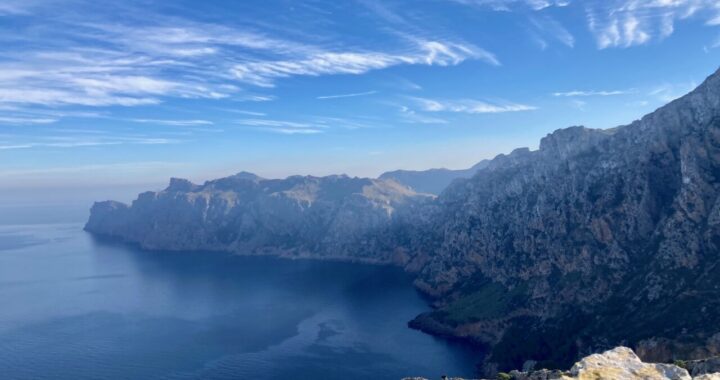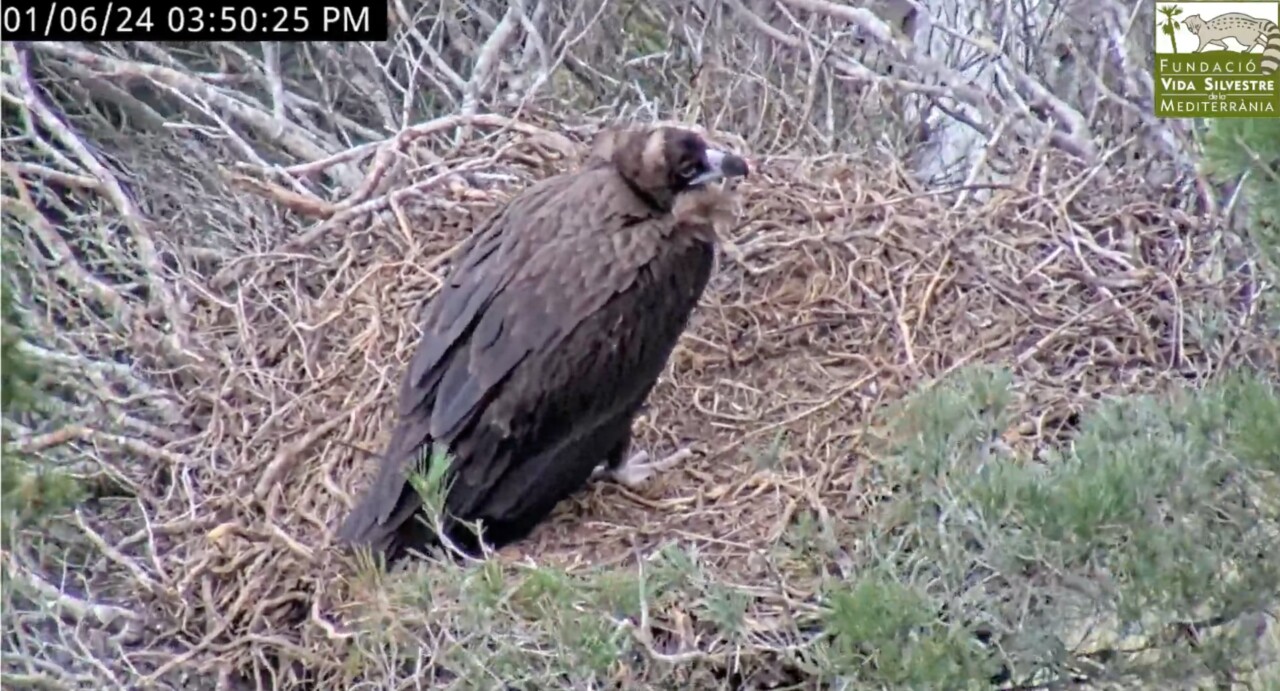The property covers six kilometers of coastline and is located at the northern part of the Serra de Tramuntana, the mountain range along the northwest coast of the Spanish island. Here lives the world’s only insular population of the black vulture.
In the 1980s, only 18 of these impressive birds of prey were estimated to be alive and only one breeding pair. The Black Vulture Conservation Foundation (BVCF) has been working to protect the black vulture in Mallorca since 1987. The good news is that currently more than 300 birds and more than 45 breeding pairs have been counted.
On a sunny December morning, just outside the northern, small historic town of Pollença, we drive up a narrow, somewhat bumpy path, the kind of paths you see so much on the island. But the difference here is, it’s a path with a significant climb. At a slow pace, relieved that I don’t have to take those sharp turns myself, we keep climbing. As we go up, the meters-high pines let the rays of the winter sun through, until old oak trees and fields of lush olive trees come into view and we enter the valley.
Breeding site for various birds of prey
The property has an impressive size of 1,000 hectares, 47 of which are traditional farmland where organic farming is practiced. This is done with the technical support of the island’s ecological farming organisation, APAEMA (Associació Producció Agrària Ecològica Mallorca). Donkeys, sheep, cows and mountain goats live here. No people, or it must be the employees of the Mediterranean Wildlife Foundation who only come here to maintain the spacious area.
It’s a breeding site for the black vulture, the osprey and Eleonora’s falcon. Also for the ferret. We see chestnut, carob and almond trees and various fruit trees such as fig and plum trees. Meanwhile also serving as protection and food for the animals. Organic beekeeping also takes place here. The Mediterranean Wildlife Foundation sells the organic products, beef and lamb, and honey and fruit directly to consumers.
Abundant world
Suddenly I find myself in a complete different world. An abundant world ending with imposing cliffs jutting out into the Balearic Sea. Against the cliffs we find an old house. At night, the starry sky must be fabulous, because in the wide surroundings there isn’t a single ray of artificial light. While driving, we see some vultures soaring high in the sky. Whether we will see the young black vulture soaring like this, we won’t know until later.
But this is just a glimpse of the sheer beauty that this property is known for. As the walk toward the direction of the nesting area begins, I am immersed in a magical landscape. Evelyn Tewes, director of the foundation, says it’s the last day a human will come here, as the breeding season begins. No one enters this section until July so the birds can breed and live undisturbedly.
The hike takes at least half an hour and goes over stones, along boulders and through blades of grass. The smell of rosemary is ubiquitous among the little pink flowers of rock-rose, both typical of the Mediterranean landscape. The area ends with a cliff that reaches into the calm sea below our feet. On the cliffs standing out across the bay, a nest can be seen with the help of binoculars. The young vulture’s nest is also on the other side, but farther away.
In this dreamy view of the Balearic Sea the black vultures do not show themselves today, but I could sit here and stare into the deep blue for hours. Here you don’t see a fake world, but purity and truth. Nothing else seems important anymore. That effect, that sense of presence and truthfulness, which we’re often so eagerly seeking, the natural world simply conveys it to us. We only need to immerse ourselves with our eyes open. ‘In nature there’s always an open book for all eyes,’ the Enlightenment-philosopher, Jean Jacques Rousseau, already wrote ages ago.
World Heritage
Chaos comes to a halt. If only for a moment. This is why the idyllic Serra de Tramuntana, of which this is all part of, has been declared a UNESCO World Heritage Site. And I can see why. This world is priceless.
We climb a little higher; silence is important here, because the animals must not be disturbed. The birds, however, don’t show themselves to us. Most of the guests take countless photos of the sensational view, me too, as if we want to own its purity. Taking in the beauty without an iPhone in one hand isn’t easy. Just letting it settle in the mind isn’t enough. We want an imprint. We want proof.
Since 2012, this property has been owned by the Mediterranean Wildlife Foundation. An exceptional donation from a nature and wild life-loving couple with the goal of ensuring habitat for the black vulture and other wild life, such as the hawk. Turning down all offers from developers to buy the estate, the couple instead donated it to the Mediterranean Wildlife Foundation. The foundation ensures the preservation of biodiversity and the continuity of traditional and ecological agricultural activities, as well as the preservation of cultural heritage. Its cultural heritage includes not only wildlife, but also defense towers from the 10th and 15th century and a network of caves. Unfortunately, too much to visit in the few hours we will be here.
The next day after an overnight stay at the monastery of Lluc near the mountain village of Escorca my partner and I see, while we’re cycling, high above the rugged mountain peaks a flock of birds of prey hovering around. Black vultures? Undetectable to the naked eye. The young vulture is being monitored and from video footage we know it has been here too. There’s something beautiful about it: these wild animals decide for themselves when they will show themselves to me. In the distance, I see them casually soaring. With admiration and a touch of jealousy I watch them fly.
From the comfort of my chair
Currently, I can watch the young black vulture, its parents and another pair (did you know that black vultures are extremely picky and choose mates for life?) just at home from the comfort of my chair via live streaming on the foundation’s YouTube channel. Last week new cameras were installed to keep monitoring the birds. Today I have been watching for quite some time. You may be thinking, vultures aren’t that beautiful, not cuddly, besides, they are fundamental scavengers, what’s so fascinating about them?
First of all, this bird of prey has a key role in the eco-system. Because the black vulture only eats carcasses, for example of livestock animals, they ensure that diseases cannot be spread. They clean up everything. Secondly, this animal that in full flight has a wingspan of almost three meters emanates a tremendous power for which you can have nothing but reverence. How they soar on the warm air streams leaves no human unmoved.
But Mallorca’s black vulture is vulnerable as shepherds disappear from the region, farmers use poisons to kill predators and rodents, and farmers treat their livestock with the anti-inflammatory and painkiller Diclofenac, causing death of vultures eating carcasses contaminated with these drugs. Also by increasing tourism, such as more and more hikers exploring the high trails in Tramuntana. Had it not been for this foundation, its partners, and its recovery program, Mallorca nowadays would most likely exist without the black vulture.
Adopted by ‘Amics dels Voltors’
The young black vulture, one of 34 birds born in the past year, has been given the name Onyx, after the black stone, by a group of wild life and nature loving people, Amics dels Voltors, who adopted the animal and gave financial support in order to keep monitoring Onyx by the installment of two new cameras. Whether Onyx is a male or female cannot yet be seen, because the appearance of male and female is the same (this is a so called monomorphic species).
This strong animal has more than completed its first flight on September 25 and since then has managed to explore the Serra de Tramuntana very well, even the center of the island, the Pla de Mallorca, after which the young black vulture returns to the nest to sleep, rest and seek shelter during storms. It’s equipped with a light GPS-tracker to observe its movements. Later, when the camera again catches the young bird and I see on my screen the animal sitting alone at that height, rocked back and forth by the wind, it touches me. It’s a feeling for which I can’t find the right word yet. Strength and vulnerability seem to unite in this beautiful, young animal.
Today on the live streaming (with the help of the new cameras) I see very clearly the black vulture in the nest. Every now and then it looks straight into the camera. There is another pair. Last year this pair lost their only egg due to the heavy storm Juliette that ravaged parts of the island in February. Now I see the pair busy with new preparations, the nest is being restored with twigs which they brought with them, some courting takes place, beaks stir in each other’s long necks and later in the afternoon it really happens: the first mating of the new year.
More information and opportunities to help support the vultures in Mallorca, please visit the website of Fundación Vida Silvestre Mediterránea (FVSM): https://fvsm.eu or send a message.


